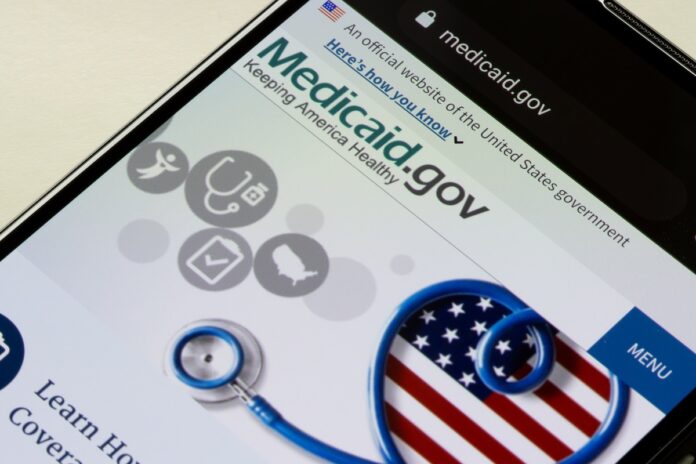
WASHINGTON (States Newsroom) — The Congressional Budget Office said Wednesday that potential major cuts and changes to Medicaid under consideration by Republicans could mean states would have to spend more of their own money on the program, reduce payments to health care providers, limit optional benefits and reduce enrollment.
The end result, under some scenarios, could be millions of Americans would be kicked off Medicaid and possibly left without health insurance, said the nonpartisan agency relied on by Congress for budget estimates.
The letter from CBO stemmed from a request by Senate Finance Committee ranking member Ron Wyden, D-Ore., and House Energy and Commerce ranking member Frank Pallone, D-N.J.
Both oppose GOP attempts to slash federal funding for the health care program for lower-income Americans and some people with disabilities. Republicans, who have not settled on an approach, say they are interested in ending waste, fraud and abuse in the program.
CBO Director Phillip Swagel wrote that possible Medicaid changes would likely lead to several outcomes in the states. The impact on states would occur because the federal government covers at least 50% of the cost of the program, with that share increasing in states with lower per capita incomes and those that expanded eligibility under the Affordable Care Act.
Wyden wrote in a statement the CBO letter showed “the Republican plan for health care means benefit cuts and terminated health insurance for millions of Americans who count on Medicaid.”
Pallone wrote in a statement of his own that reducing federal funding for the program by hundreds of billions of dollars would lead to “millions of people losing their health care.”
“(President Donald) Trump has repeatedly claimed Republicans are not cutting health care, but CBO’s independent analysis confirms the proposals under consideration will result in catastrophic benefit cuts and people losing their health care,” Pallone wrote. “It’s time for Republicans to stop lying to the American people about what they’re plotting behind closed doors in order to give giant tax breaks to billionaires and big corporations.”
The Medicaid changes would come as Republicans use the complex budget reconciliation process to move a sweeping legislative package through Congress with simple majority votes in each chamber, avoiding the Senate’s 60-vote filibuster, which would otherwise require bipartisanship.
The House Energy and Commerce Committee, which is tasked with cutting at least $880 billion from the programs it oversees — including Medicaid — during the next decade, has yet to release its bill that if approved by the committee will become part of that package.
The panel, led by Kentucky Republican Rep. Brett Guthrie, is expected to debut its proposed changes next week before debating the legislation during a yet-to-be-scheduled markup.
Republicans plan to use the reconciliation package to permanently extend the 2017 tax law, increase spending on border security and defense by hundreds of billions of dollars, overhaul American energy production, restructure higher education aid and cut spending.
Five scenarios
CBO’s analysis looked at five specific Medicaid scenarios including:
- Congress reducing the federal match rate for the 40 states that expanded Medicaid eligibility under the Affordable Care Act, also known as Obamacare.
- Lawmakers eliminating a 6% threshold that exists for states that collect higher taxes from health care providers and then return that additional money in the form of higher Medicaid payments. CBO writes those “higher Medicaid payments increase the contributions from the federal government to states’ Medicaid programs.”
- Republicans creating a per-enrollee cap on federal spending.
- Congress establishing a cap on federal spending for Medicaid enrollees who became eligible for the program after their state expanded eligibility under the ACA.
- Lawmakers repealing two Biden-era rules that addressed the Medicare Savings Programs and standardized how states approached enrollment and renewals.
The analysis said states could raise taxes or cut spending on other programs to replace the lost federal revenue that would coincide with the first four scenarios, though CBO “expects that such steps would prove challenging for many states.”
“In CBO’s view, different states would make different choices regarding how much of the reduced Medicaid funds to replace,” the analysis states. “Instead of modeling separate responses for each state, the agency estimated state responses in the aggregate, accounting for a range of possible outcomes.”
Overall, CBO expects state governments would be able to replace about half of the lost federal revenue and that they would “reduce provider payment rates, reduce the scope or amount of optional services, and reduce Medicaid enrollment” to address the other half.
Alternatives studied
The first scenario, where lawmakers reduce the federal matching rate for expanded Medicaid populations, would save the government $710 billion during the next decade.
But in 2034, CBO expects that “2.4 million of the 5.5 million people who would no longer be enrolled in Medicaid under this option would be without health insurance.”
CBO wrote that in the second, third and fourth scenarios, “Medicaid enrollment would decrease and the number of people without health insurance would increase.”
The second scenario of limiting state taxes on health care providers would save the federal government $668 billion during the 10-year budget window. It would lead to 8.6 million people losing access to Medicaid with a 3.9 million increase in the uninsured population by 2034.
The third projection that looked at a federal cap on spending per enrollee would reduce federal spending by $682 billion during the next decade. A total of 5.8 million people would lose Medicaid coverage and 2.9 million would become uninsured under that proposal.
And the fourth scenario, where Congress caps federal spending per enrollee in the expansion population, would cut the deficit by $225 billion during the next 10 years. More than 3 million people would lose Medicaid coverage and 1.5 million would become uninsured under this scenario.
Under the fifth scenario, where GOP lawmakers would change two Biden-era rules, CBO expects that the federal government would spend $162 billion less over the 2025–2034 window.
“CBO estimates that, in 2034, 2.3 million people would no longer be enrolled in Medicaid under this option,” the letter states. “Roughly 60 percent of the people who would lose Medicaid coverage would be dual-benefit enrollees who would retain their Medicare coverage.”







